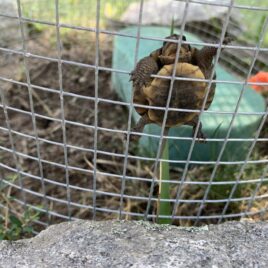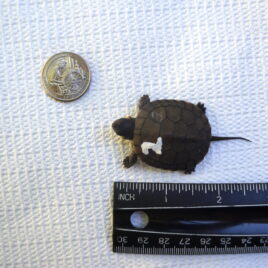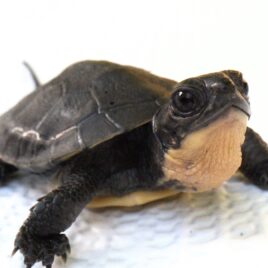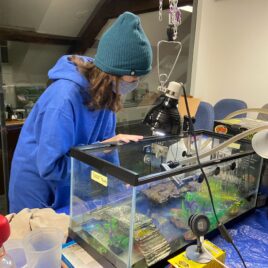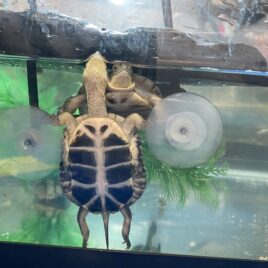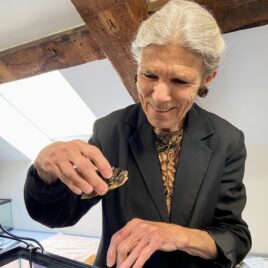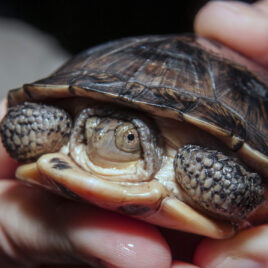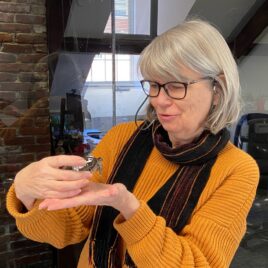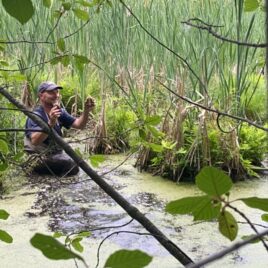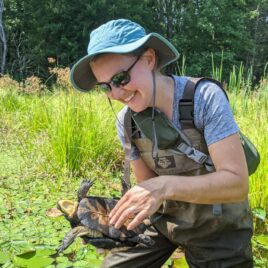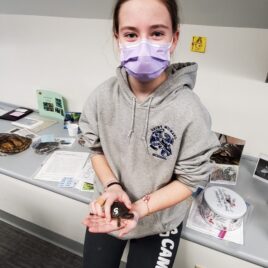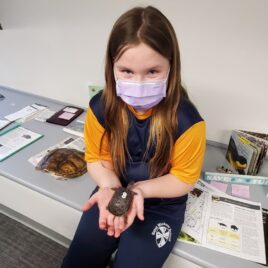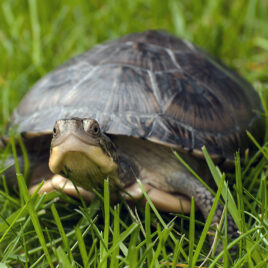Why Blanding’s Turtles?
You’ve likely heard of, or seen, painted turtles (aka “sun turtles”) and snapping turtles, but have you heard of Blanding’s turtles? Blanding’s are also native to New England, but you’re less likely to encounter this species because their numbers have declined over the years. Blanding’s turtles are on the Massachusetts Endangered Species list under Threatened Status.
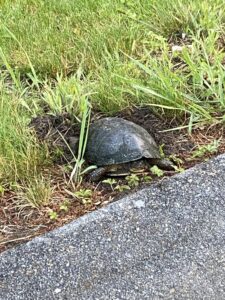
A female Blanding’s turtle digging a nest along the side of the road in June.
Why are they threatened?
As with many animals in our area, turtles face a variety of challenges. Their habitats have been disrupted by buildings and roads and they have to cross these roads to find suitable nesting areas. Eggs and hatchlings are also at risk of predation by several animals including skunks, foxes, raccoons, and birds of prey. Only about 1% of all Blanding’s turtle hatchlings will survive long enough to reach sexual maturity.
Blanding’s turtles are even more vulnerable because they:
-
travel long distances during the nesting season (May – July)
-
do not reproduce until at least 14 years old, but closer to 17-20 years on average
-
require many types of habitats:
-
upland vernal pools as a food source
-
open, gravelly, upland areas for nesting
-
marshy and shrubby wetlands for moving among in the summer
-
permanent wetlands for overwintering
Why should you care?
All turtles play an important role in maintaining the balance of our ecosystem. They are part of the food web as both predators and prey. As semi-aquatic omnivores, they eat crayfish, earthworms, insects, small fish, and other small vertebrates, along with plants like coontail, duckweed, and sedge. Turtle eggs and hatchlings also provide a seasonal protein source for some mammals and birds.
Turtles evolved over 200 million years ago and have adapted to almost any habitat, but they are in danger now because of humans. Their primary threat is the loss, degradation, and fragmentation of their habitat. Road crossings, disease, and illegal hunting also contribute to their decline.
There could be less than 3,000 Blanding’s turtles left in the Northeast. Several agencies and non-profits are working together to recover and boost the population in Massachusetts, including MassWildlife, the US Fish & Wildlife Service, Zoo New England, and LP&CT.
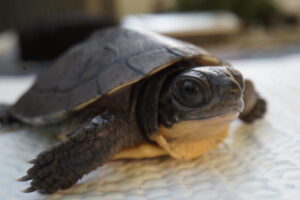
A Blanding’s turtle hatchling at only a few days old
How can you help?
Habitat conservation is key to the survival of any species. The Lowell Parks & Conservation Trust has worked to protect land throughout the city, including several parcels that are critical habitats for turtles and other wildlife.
The protection of Pawtucket Farm also protects another 20 acres of habitat that is connected to the Lowell-Dracut-Tyngsboro State Forest, additional habitat for turtles. Vernal pools also exist within the state forest and are a vital source of turtle prey.
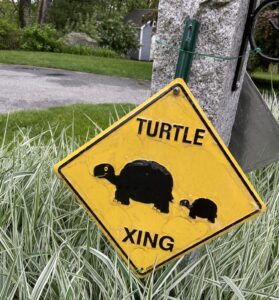 If you’re driving and notice a turtle crossing the road, you can stop to let it cross, or carefully pick it up and place it in the same direction it was facing to cross the road. Turtles instinctively know where they are going, so do not assume it should be brought back to a pond. If turtles live near you, educate your neighbors about turtles and notify drivers with signs.
If you’re driving and notice a turtle crossing the road, you can stop to let it cross, or carefully pick it up and place it in the same direction it was facing to cross the road. Turtles instinctively know where they are going, so do not assume it should be brought back to a pond. If turtles live near you, educate your neighbors about turtles and notify drivers with signs.
Support our Blanding’s turtle headstarting program in partnership with Zoo New England. Make a donation or become a volunteer to help with the general caretaking of this protected species, including feeding, tank cleanings, and nest monitoring in the late spring and summer.
Turtle Headstarting Program
The Lowell Parks & Conservation Trust has helped facilitate turtle headstarting in Lowell Public Schools since 2015 along with the Assabet Wildlife Refuge. We began our own in-house program in partnership with Zoo New England and Mass Wildlife after rescuing eight hatchlings from a local nest in 2020.
Zoo New England’s headstarting program (HATCH) allows for turtle hatchlings to be raised in captivity, short-term, in order to increase their chances of survival into adulthood. The turtles live in tanks for approximately 10 months, growing larger and stronger in a short period of time. When they are ready to be released back to their original home in the wild, they are the size of a 3-4 year old juvenile turtle and have over an 85% chance of surviving the first year. They have over a 90% survival rate beyond the first year according to studies by Zoo New England (ZNE).
Head-started turtles spend their time in consistently warm water (78-82 degrees F), have a UV light on during the day to bask under (to increase the strength of their shell), and are fed twice per day, excluding weekends. Schools around Massachusetts, including Lowell Public Schools, take part in headstarting programs, which align with the school year. Zoo New England estimates that nest protection and headstarting together will increase the likelihood of Blanding’s turtles surviving from egg to adulthood by about 40 fold.
 The success of our turtle program depends on a dedicated and caring Turtle Team of volunteers! If you’re interested in volunteering to help with the general caretaking of this protected species, including feeding, tank cleanings, and/or nest monitoring in the late spring and summer, please complete our online volunteer application!
The success of our turtle program depends on a dedicated and caring Turtle Team of volunteers! If you’re interested in volunteering to help with the general caretaking of this protected species, including feeding, tank cleanings, and/or nest monitoring in the late spring and summer, please complete our online volunteer application!
We also live-stream our head-started turtles! Check out the webcam from 7 AM – 9 PM, from approximately September – June.
For Teaching Resources and more, please scroll below the Gallery of photos.




 If you’re driving and notice a turtle crossing the road, you can stop to let it cross, or carefully pick it up and place it in the same direction it was facing to cross the road. Turtles instinctively know where they are going, so do not assume it should be brought back to a pond. If turtles live near you, educate your neighbors about turtles and notify drivers with signs.
If you’re driving and notice a turtle crossing the road, you can stop to let it cross, or carefully pick it up and place it in the same direction it was facing to cross the road. Turtles instinctively know where they are going, so do not assume it should be brought back to a pond. If turtles live near you, educate your neighbors about turtles and notify drivers with signs.
 The success of our turtle program depends on a dedicated and caring Turtle Team of volunteers! If you’re interested in
The success of our turtle program depends on a dedicated and caring Turtle Team of volunteers! If you’re interested in 